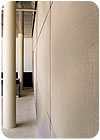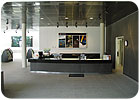
When the Commonwealth of Pennsylvania decided to construct the new $9.9 million, energy-efficient Welcome Center in the Delaware Water Gap, interior and exterior building materials were selected with two characteristics in mind: both had to have a high degree of environmental- and flood-friendliness. Because the facility was built in a low-lying area near the Delaware River, and because the Commonwealth has a goal of reducing energy costs by 15-percent in 2007, these design criteria were critical.
Rooftop gardens, geothermal heating and cooling, ample windows for day lighting and sustainable products like architectural mesh, all contributed to the project’s LEED silver certification submission.
The Pennsylvania Department of General Services managed the design and construction of the 12,700-square-foot welcome center, just one of the capital construction projects they manage for the commonwealth to save energy and cut operating costs.
The modern structure’s exterior consists of concrete and granite veneer and the interior features stainless steel mesh walls, granite flooring, metal ceiling panels and cement – all green and all flood-resistant.
THE COMING STORM
The Federal Emergency Management Agency defines flood-resistant materials as capable of withstanding direct and prolonged contact with floodwaters without sustaining significant damage that requires more than low-cost cosmetic repair.A classification system with rankings from 1 to 5 is used to qualify how well materials meet this standard. Class 5 materials are highly resistant to floodwater damage and Class 1 materials are not resistant. For flooring materials, clay and concrete tiles, as well as precast and in-situ concrete, are ranked as Class 5, the most flood resistant. The best-performing wall and ceiling materials according to FEMA are brick, cement board, metal and glass.
Most materials chosen for the Welcome Center project are practically indestructible, like Cambridge Architectural’s Space Sculpting mesh system, which provides an attractive backdrop and durable adornment for the interior reception area. It has a long lifecycle and requires little maintenance. In the event of flooding, the stainless steel material can be easily cleaned with a soft cloth, water-soluble detergent, or even a vacuum cleaner.
The Space Sculpting mesh system was created with Cambridge’s Bead metal fabric. The metal fabric pattern was fixed to a feature wall behind the reception desk using Tableau and Panel attachment hardware, made into panels hung on the desk itself.
“We chose materials that would be the most flood-resistant, like concrete, glass, cement board and metal,” explains Bob Bamford, project manager from Mar-Paul Construction Co. in Jessup, Penn., the project’s general contractor. “Sure enough, when the project was 50-percent complete, there was major flooding throughout the building,”
“Cambridge’s mesh system was one of those products that we knew would be perfect for this project,” adds Bamford. “The material is indestructible, functional and adds an element of visual interest to this very contemporary space.”
“Since the building is located near the Delaware River, flooding could very likely happen again, and unfortunately, it did happen again – several months after the facility opened – but the materials were all easily cleaned and performed exceedingly well,” continues Bamford.
The project was designed by Maria C. Romanach Architects of Philadelphia and was built in partnership with the Department of General Services, the Pennsylvania Historical and Museum Commission, the Department of Community and Economic Development, and Pocono Mountains Vacation Bureau, Inc., which represents the tourism industry in Pennsylvania’s Carbon, Monroe, Pike and Wayne counties.

HIGH-TRAFFIC AREA
After 13 months of construction, the facility opened to the public for Memorial Day weekend 2006, and serves travelers on Interstate 80 as they enter Pennsylvania from New Jersey. The center is operated by the Pennsylvania Department of Transportation and is open 24 hours a day, seven days a week.Replacing a one-room Welcome Center built in 1956, the new facility offers the usual restrooms and vending machines, but also traveling services such as personalized travel counseling, assistance with directions, and plenty of information on accommodations and the state’s natural, scenic and historic attractions.
The Delaware Water Gap is a mountain pass cut through the Appalachian Mountains between New Jersey and Pennsylvania. The surrounding 70,000 acres of the Delaware Water Gap National Recreation Area is a popular destination for fishing, canoeing, rock climbing, hiking and all types of outdoor activities.
“The design of this sleek, contemporary facility contains many building elements which contribute to its efficiency, such as a geothermal heating and cooling systems and large window walls,” concludes Bamford. “The cutting-edge design elements throughout the space not only look good, but were chosen to stand up to everyday wear and tear.”
The rigid metal fabric selected for the mesh walls performs exceedingly well in high-traffic areas - like the lobby at the Welcome Center, which sees thousands of visitors each day. Woven metal is most often manufactured from stainless steel which is inherently resistant to scratches, denting, and corrosion.
The mesh system is also very lightweight and requires minimal structural support, reducing the cost of materials and labor. In addition, woven metal fabrics and attachment hardware are recyclable and can be fabricated from recycled materials.
The green building materials specified for the facility offer specific benefits such as reduced maintenance costs over the life of the building, energy efficiency and greater design flexibility. As a result, it is a cleaner, fresher building that has a reduced overall environmental impact.
MADE IN THE SHADE
Another project, due to be completed in 2008, features a different architectural mesh from Cambridge, but instead of being mounted as an interior wall covering, the mesh is mounted on the exterior of the building to provide solar shading benefits.The project, the University of Washington’s Medicine Lake Union Building, is implementing mid-balance metal fabric mounted with a modified Cambridge Eclipse attachment method. Like traditional shading materials, the mesh significantly reduces solar glare, light pollution and solar heat gain, but also provides for airflow and building security and is designed to meet an array of opacity, shading and heat reduction requirements.
“When we first began designing the exterior skin of the Medicine Lake Union project, we knew we wanted to implement a shading system to control the amount of solar heat gain entering the building from the western and southern facades,” explains Andrew Clinch, University of Washington Medicine Lake Union Building project architect and designer. “After weighing our options, we chose a woven metal fabric due to its texture and transparency.
“We chose Mid-Balance metal fabric pattern because we were able to customize the exact opacity to meet our 52 percent energy requirements. The metal fabric design turned out to be exactly what we were looking for: a lightweight exterior shading application that allowed natural light to fill in the lab spaces while simultaneously controlling solar heat gain and reducing our energy costs.”
To assist architects and engineers working on building designs, Cambridge recently developed a solar heat gain coefficient report and U.S. Department of Energy model to determine energy reduction capabilities possible with the exterior mesh system. The DOE model examined the energy and financial impact from the installation of a mesh screen with 50 percent coverage onto a 30-story commercial office building with clear, double-glazed windows. Results from the study show a considerable decrease in energy costs. Specifically, the study predicts a savings of $94,000 annually for the commercial building under analysis.
Sidebar: Flood-Resistant Classification of Materials
NFIPClass
Class Description
Acceptable
5
Highly resistant to floodwater damage. Materials within this class are permitted for partially enclosed or outside uses with essentially unmitigated flood exposure.
4
Resistant to floodwater damage. Materials within this class may be exposed to and/or submerged in floodwaters in interior spaces and do not require special waterproofing protection.
Unacceptable
3
Resistant to clean water damage. Materials within this class may be submerged in clean water during periods of intentional flooding.
2
Not resistant to water damage. Materials within this class require essentially dry spaces that may be subject to water vapor and slight seepage.
1
Not resistant to water damage. Materials within this class require conditions of dryness.

Report Abusive Comment